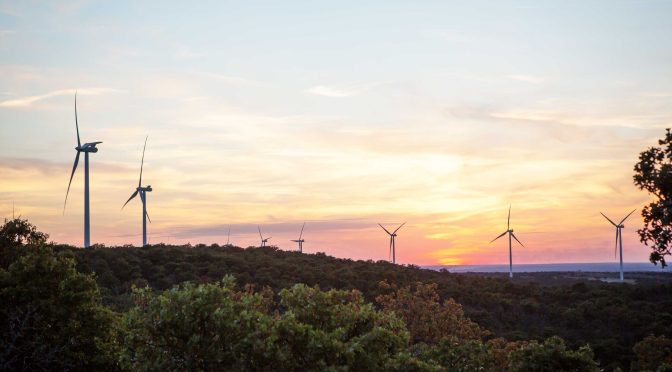Our strategic plan for 2023-2025 focuses on sustainable electrification and a strategic repositioning of the Group in six “core” countries. In three years’ time, 75% of the energy generated by Enel will be renewable.
Accelerating the transition to renewable sources, in order to protect the climate and reduce the dependence of individual countries on imported fossil fuels, is a path that Enel has been on for several years now. But it is also a choice that must be strengthened today, in order to overcome the “turbulence” of the last few years, as Group CEO Francesco Starace described it. First the Covid-19 pandemic and then the conflict in Ukraine, along with global supply chain difficulties and soaring gas prices: all of these factors are combining to affect everything from people’s quality of life to international development. In the meantime, extreme weather events linked to global warming have intensified, because the climate will not wait for us. Changing the way we produce energy also helps to ensure freedom and energy independence for Italy and the countries in which we operate.
This is the commitment set out by our Group in its strategic plan for the 3-year period 2023-2025, presented in Milan on November 22 during Capital Markets Day, the annual event at which CEO Francesco Starace and CFO Alberto De Paoli outlined the details of our plan to the financial world.
Stability against volatility. Security against uncertainty. Energy independence, guaranteed by production from renewable sources, and affordability for consumers. These are the key elements of what Starace described as a “strategic repositioning” which aims to create a leaner corporate structure to better tackle future challenges. Enel Green Power has the essential task of implementing this strategy by significantly strengthening renewable capacity over the next three years.
Sustainable electrification and renewables
The choice, said Starace, is to “concentrate our efforts where they matter most”, so our strategic plan is centered around a series of clear and precise goals for 2025. To achieve these goals, the Group expects to invest around €37 billion.
The first goal involves sustainable electrification, a process that we will accelerate in our “core” countries: Italy, Spain, the United States, Brazil, Chile and Colombia, until we produce 90% of electricity sold at a fixed price from renewable sources, bringing clean energy generation to 75% of the total (as opposed to the current 55%) and digitalizing 80% of grid customers.
End-use electrification will range from increasing the number of electric vehicle charging points (from around 0.4 million in 2022 to 1.4 million in 2025), to expanding storage capacity from 99 to 352 MW and to increasing demand-response capacity, which is expected to rise from the present 8.4 to 12.4 GW by the end of the three-year period.
We will also significantly bolster installed renewable capacity with an additional 21 GW (including 4 GW of batteries for electricity storage). Out of the total 21 GW, 9 will be in Europe and 10 will be in the United States and Latin America, thanks to long-term PPAs, contracts that regulate the provision of electric energy between a producer and a purchaser. Another 2 GW will go to expanding markets thanks to the stewardship business model, which promotes third-party investments in partnership with Enel, or in the context of investment platforms.
This will bring the Group’s total consolidated renewable capacity to around 75 GW by the end of 2025, supported by one of the most extensive pipelines in the world.
More autonomy in the supply chain and fewer greenhouse gases
The stewardship model – the involvement of other financial and industrial partners – will also be applied to facilitate the strategic restructuring of some of our supply chains in key areas. The best example is3Sun, our solar panel gigafactory in Sicily which is set to increase production from 200 MW to 3000 MW a year, while also improving panel efficiency by almost a third. It’s an initiative that will contribute to an increasingly widespread use of renewables and which, Starace says, “will reduce our dependency on Asia for this type of technology – something which hasn’t negatively affected us yet, but which potentially risks doing so if we don’t make an effort to become more independent.” The investment will also create around 1,000 new jobs, and Starace confirmed during Capital Markets Day that plans are already in the works for a 3Sun “sister” factory to be built in the United States.
Our goal, of course, remains focused on decarbonization and Zero Emissions. The end goal – the elimination of our greenhouse gas emissions – is scheduled for 2040. In the meantime, however, we expect a drop in the so-called Scope 1 emissions (direct emissions generated by our company) to 130 grams of CO2 equivalent per KWh by 2025 compared to the current figure of 223, which will then fall to 82 in 2030. As regards gas sales (which will end in 2040), Scope 3 emissions (indirect emissions which occur from sources not owned or controlled by our company) will fall to 20.9 gCO2E/KWh from the current 24.1.
For some years now, our Group has been on a path towards clean electrification, clearly a winning choice in light of the current crisis and also an area of growth for the future. We will increase “our resilience, and position our value creation for further growth, benefitting all our stakeholders and accelerating energy independence in our ‘core’ countries,” explained Starace. “Sustainability, which is fully integrated in all our decisions, continues to be the foundation of our strategy, while also leveraging the acceleration of electrification across all economies.”


